Experimental Demonstration of Nanoscale Pillar Phononic Crystal-Based Reflector for Surface Acoustic Wave Devices
Abstract
1. Introduction
2. Device Modeling and Method of Calculation
2.1. Dispersion and Transmission Characteristics
2.2. Influence of Pillar Shape on Bandgap
2.3. Influence of Pillar Material on Bandgap
2.4. Application in SAW Resonators
3. Device Fabrication
4. Discussion
5. Conclusions
Author Contributions
Funding
Data Availability Statement
Conflicts of Interest
References
- Liu, Y.; Lin, B.; Xie, Y.; Soon, B.W.; Cai, Y.; He, J.; Sun, C. Boosting Performance of SAW Resonator via AlN/ScAlN Composite Films and Dual Reflectors. IEEE Trans. Ultrason. Ferroelectr. Freq. Control 2023, 70, 1239–1245. [Google Scholar] [CrossRef]
- Huang, Y.; Huang, Y.; Bao, J.; Li, X.; Zhang, B.; Qiu, L.; Omori, T.; Hashimoto, K.-Y. Analysis of SAW Scattering With Discontinuous Periodic Gratings Using Travelling Wave Excitation and Hierarchical Cascading Technique. IEEE Trans. Ultrason. Ferroelectr. Freq. Control 2019, 66, 1255–1263. [Google Scholar] [CrossRef]
- Wu, Z.; Liu, Y.-M.; Shi, B.; Bao, J.-F.; Hashimoto, K.-Y. COM-based Modeling of SAW Scattering at Reflector Outer Edges in I.H.P. SAW Resonator. In Proceedings of the IEEE International Ultrasonics Symposium (IUS), Venice, Italy, 10–13 October 2022. [Google Scholar] [CrossRef]
- Omori, T.; Akasaka, J.; Arai, M.; Hashimoto, K.; Yamaguchi, M. Optimisation of weighted SAW grating reflectors with minimised time delay deviation. In Proceedings of the IEEE International Frequncy Control Symposium and PDA Exhibition (Cat. No.01CH37218), Seattle, WA, USA, 8 June 2001; pp. 666–670. [Google Scholar] [CrossRef]
- Ash, B.J.; Worsfold, S.R.; Vukusic, P.; Nash, G.R. A highly attenuating and frequency tailorable annular hole phononic crystal for surface acoustic waves. Nat. Commun. 2017, 8, 174. [Google Scholar] [CrossRef]
- Xie, S.; Zhu, H.; Zhang, X.; Wang, H. A brief review on the recent development of phonon engineering and manipulation at nanoscales. Int. J. Extrem. Manuf. 2024, 6, 012007. [Google Scholar] [CrossRef]
- Al-Lethawe, M.A.; Addouche, M.; Khelif, A.; Guenneau, S. All-angle negative refraction for surface acoustic waves in pillar-based two-dimensional phononic structures. New J. Phys. 2012, 14, 123030. [Google Scholar] [CrossRef][Green Version]
- Zhang, Z.-D.; Liu, F.-K.; Yu, S.-Y.; Lu, M.-H.; Chen, Y.-F. An integrable and configurable phononic beamsplitter based on self-collimated surface acousticwaves. Appl. Phys. Express 2020, 13, 044002. [Google Scholar] [CrossRef]
- Yantchev, V. Complete bandgap SAW phononic resonators. In Proceedings of the 2014 European Frequency and Time Forum (EFTF), Neuchatel, Switzerland, 23–26 June 2014; pp. 282–285. [Google Scholar] [CrossRef]
- Liu, K.; Wang, Y.; Wu, T. Design and Analysis of Phononic Crystal Reflector for Surface Acoustic Wave Resonator. In Proceedings of the 2021 IEEE International Ultrasonics Symposium (IUS), Xi’an, China, 11–16 September 2021; pp. 1–4. [Google Scholar] [CrossRef]
- Assouar, B.; Oudich, M. Dispersion curves of surface acoustic waves in a two-dimensional phononic crystal. Appl. Phys. Lett. 2011, 99, 123505. [Google Scholar] [CrossRef]
- Benchabane, S.; Khelif, A.; Robert, L.; Rauch, J.Y.; Pastureaud, T.; Laude, V. Elastic band gaps for surface modes in an ultrasonic lithium niobate phononic crystal. In Proceedings of the SPIE, Photonic Crystal Materials and Devices III (i.e. V), Strasbourg, France, 3–6 April 2006; Volume 6182, p. 618216. [Google Scholar] [CrossRef]
- Achaoui, Y.; Khelif, A.; Benchabane, S.; Robert, L.; Laude, V. Experimental observation of locally-resonant and Bragg band gaps for surface guided waves in a phononic crystal of pillars. Phys. Rev. B 2011, 83, 104201. [Google Scholar] [CrossRef]
- Talbi, A.; Du, Y.; Yankin, S.; Streque, J.; Gerbedoen, J.-C.; Mrabti, A.; Akjouj, A.; Pennec, Y.; Rouhani, B.D.; Pernod, P.; et al. Experimental investigation of surface acoustic wave interaction with 2D array PnC with various lattice symmetries. In Proceedings of the IEEE International Ultrasonics Symposium (IUS), Prague, Czech Republic, 21–25 July 2013; pp. 2130–2132. [Google Scholar] [CrossRef]
- Wang, J.-Q.; Zhang, Z.-D.; Yu, S.-Y.; Ge, H.; Liu, K.-F.; Wu, T.; Sun, X.-C.; Liu, L.; Chen, H.-Y.; He, C.; et al. Extended topological valley-locked surface acoustic waves. Nat. Commun. 2022, 13, 1324. [Google Scholar] [CrossRef]
- Nikitov, S.A.; Grigor’evskii, A.V.; Grigor’evskii, V.I.; Kotelyanskii, I.M.; Luzanov, V.A.; Mirgorodskaya, E.N.; Suchkov, S.G. Features of propagation of surface acoustic waves in two-dimensional phononic crystals on the surface of a lithium niobate crystal. J. Commun. Technol. Electron. 2011, 56, 888–899. [Google Scholar] [CrossRef]
- Lethawe, M.A.; Benchabane, M.A.S.; Khelif, V.L.A. Guidance of surface elastic waves along a linear chain of pillars. AIP Advances 2016, 6, 121708. [Google Scholar] [CrossRef]
- Kuruoğlu, F. Influence of the Core Pillar Height on the Bandgap Characteristics of Piezoelectric Phononic Crystals with Ring-Shaped Grooves. Cumhur. Sci. J. 2022, 43, 346–350. [Google Scholar] [CrossRef]
- Sun, J.-H.; Wu, T.-T. Investigation of phononic crystal reflective gratings for surface acoustic waves. In Proceedings of the 2012 IEEE International Ultrasonics Symposium, Dresden, Germany, 7–10 October 2012; pp. 1758–1761. [Google Scholar] [CrossRef]
- Benchabane, S.; Khelif, A.; Rauch, J.Y.; Robert, L.; Laude, V. Lithium niobate phononic crystal for surface acoustic waves. In Proceedings of the SPIE, Photonic Crystal Materials and Devices IV, Strasbourg, France, 3–6 April 2006; Volume 6128, p. 61281A. [Google Scholar] [CrossRef]
- Khelif, A.; Achaoui, Y.; Benchabane, S.; Laude, V.; Aoubiza, B. Locally resonant surface acoustic wave band gaps in a two-dimensional phononic crystal of pillars on a surface. Phys. Rev. B 2010, 81, 214303. [Google Scholar] [CrossRef]
- Korotyaeva, M.E.; Kutsenko, A.A.; Shuvalov, A.L.; Poncelet, O. Love waves in two-dimensional phononic crystals with depth-dependent properties. Appl. Phys. Lett. 2013, 103, 111902. [Google Scholar] [CrossRef]
- Fu, C.; Ma, T.-X. Modulation of Surface Elastic Waves and Surface Acoustic Waves by Acoustic–Elastic Metamaterials. Crystals 2024, 14, 997. [Google Scholar] [CrossRef]
- Yudistira, D.; Boes, A.; Graczykowski, B.; Alzina, F.; Yeo, L.Y.; Torres, C.M.S.; Mitchell, A. Nanoscale pillar hypersonic surface phononic crystals. Phys. Rev. B 2016, 94, 094304. [Google Scholar] [CrossRef]
- Li, G.-Y.; Xu, G.; Zheng, Y.; Cao, Y. Non-leaky modes and bandgaps of surface acoustic waves in wrinkled stiff-film/compliant-substrate bilayers. J. Mech. Phys. Solids 2018, 112, 239–252. [Google Scholar] [CrossRef]
- Gao, F.; Benchabane, S.; Bermak, A.; Dong, S.; Khelif, A. On-Chip Tightly Confined Guiding and Splitting of Surface Acoustic Waves Using Line Defects in Phononic Crystals. Adv. Funct. Mater. 2023, 33, 2213625. [Google Scholar] [CrossRef]
- Shao, L.; Maity, S.; Zheng, L.; Wu, L.; Shams-Ansari, A.; Sohn, Y.-I.; Puma, E.; Gadalla, M.N.; Zhang, M.; Wang, C.; et al. Phononic Band Structure Engineering for High-Q Gigahertz Surface Acoustic Wave Resonators on Lithium Niobate. Phys. Rev. Applied 2019, 12, 014022. [Google Scholar] [CrossRef]
- Oudich, M.; Djafari-Rouhani, B.; Bonello, B.; Pennec, Y.; Sarry, F. Phononic Crystal Made of Multilayered Ridges on a Substrate for Rayleigh Waves Manipulation. Crystals 2017, 7, 372. [Google Scholar] [CrossRef]
- Wang, Y.; Wu, S.-M.; Yu, S.-Y.; Wu, Y.; Hao, X.; Chen, Y.-F. Phononic crystals for Love waves based on thin-film lithium niobate. J. Phys. D Appl. Phys. 2023, 56, 475103. [Google Scholar] [CrossRef]
- Kokkonen, K.; Kaivola, M.; Benchabane, S.; Khelif, A.; Laude, V. Scattering of surface acoustic waves by a phononic crystal revealed by heterodyne interferometry. Appl. Phys. Lett. 2007, 91, 083517. [Google Scholar] [CrossRef]
- Gao, F.; Khelif, A.; Benchabane, S.; Bermak, A. Shear Horizontal Phononic Metasurface for In-Liquid Gravimetric Biosensing. IEEE Electron. Device Lett. 2021, 42, 915–918. [Google Scholar] [CrossRef]
- Pouya, C.; Nash, G.R. Sub- and supersonic elastic waves in an annular hole phononic metamaterial. Commun. Mater. 2021, 2, 55. [Google Scholar] [CrossRef]
- Addouche, M.; Al-Lethawe, M.A.; Elayouch, A.; Khelif, A. Subwavelength waveguiding of surface phonons in pillars-based phononic crystal. AIP Adv. 2014, 4, 124303. [Google Scholar] [CrossRef]
- Sun, J.-H.; Jhou, J.-H. Surface acoustic wave resonator using layered phononic crystals. In Proceedings of the IEEE International Frequency Control Symposium (FCS), Taipei, Taiwan, 19–22 May 2014; pp. 1–4. [Google Scholar] [CrossRef]
- Wu, T.-T.; Wang, W.-S.; Sun, J.-H.; Hsu, J.-C.; Chen, Y.-Y. Utilization of phononic-crystal reflective gratings in a layered surface acoustic wave device. Appl. Phys. Lett. 2009, 94, 101913. [Google Scholar] [CrossRef]
- Tang, P.; Pan, H.; Workie, T.B.; Mi, J.; Bao, J.; Hashimoto, K.-Y. Honeycomb-Shaped Phononic Crystals on 42°Y-X LiTaO3/SiO2/Poly-Si/Si Substrate for Improved Performance and Miniaturization. Micromachines 2024, 15, 1256. [Google Scholar] [CrossRef]
- Workie, T.B.; Wu, T.; Bao, J.; Hashimoto, K.-Y. Design for high-quality factor of piezoelectric-on-silicon MEMS resonators using resonant plate shape and phononic crystals. Jpn. J. Appl. Phys. 2021, 60, SDDA03. [Google Scholar] [CrossRef]
- Xin, Y.-J.; Cai, P.-C.; Li, P.; Qun, Y.; Sun, Y.-T.; Qian, D.; Cheng, S.-L.; Zhao, Q.-X. Comprehensive analysis of band gap of phononic crystal structure and objective optimization based on genetic algorithm. Phys. B Condens. Matter 2023, 667, 415157. [Google Scholar] [CrossRef]
- The Engineering ToolBox. Solids and Metals—Speed of Sound. 2004. Available online: https://www.engineeringtoolbox.com/sound-speed-solids-d_713.html (accessed on 14 May 2025).
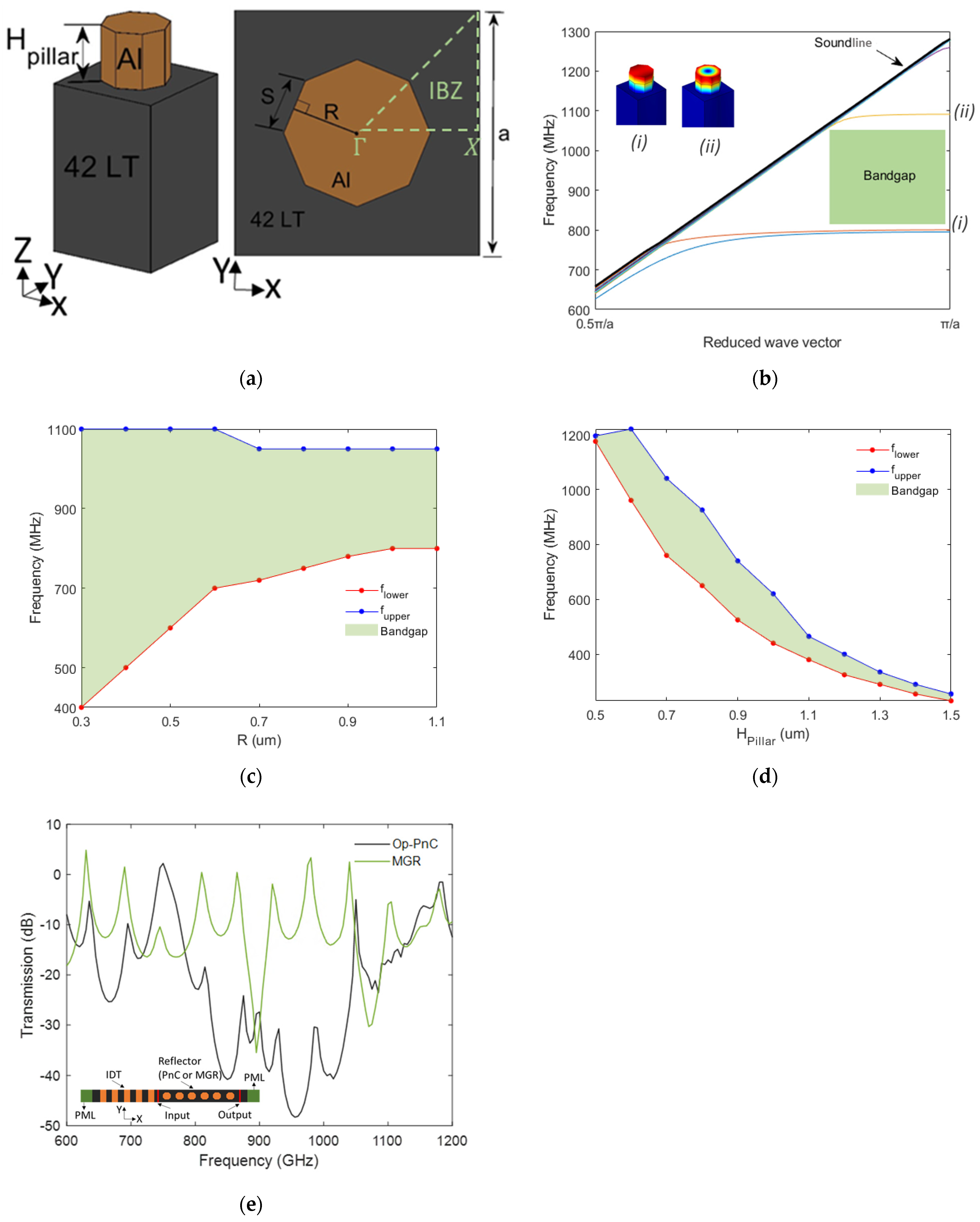
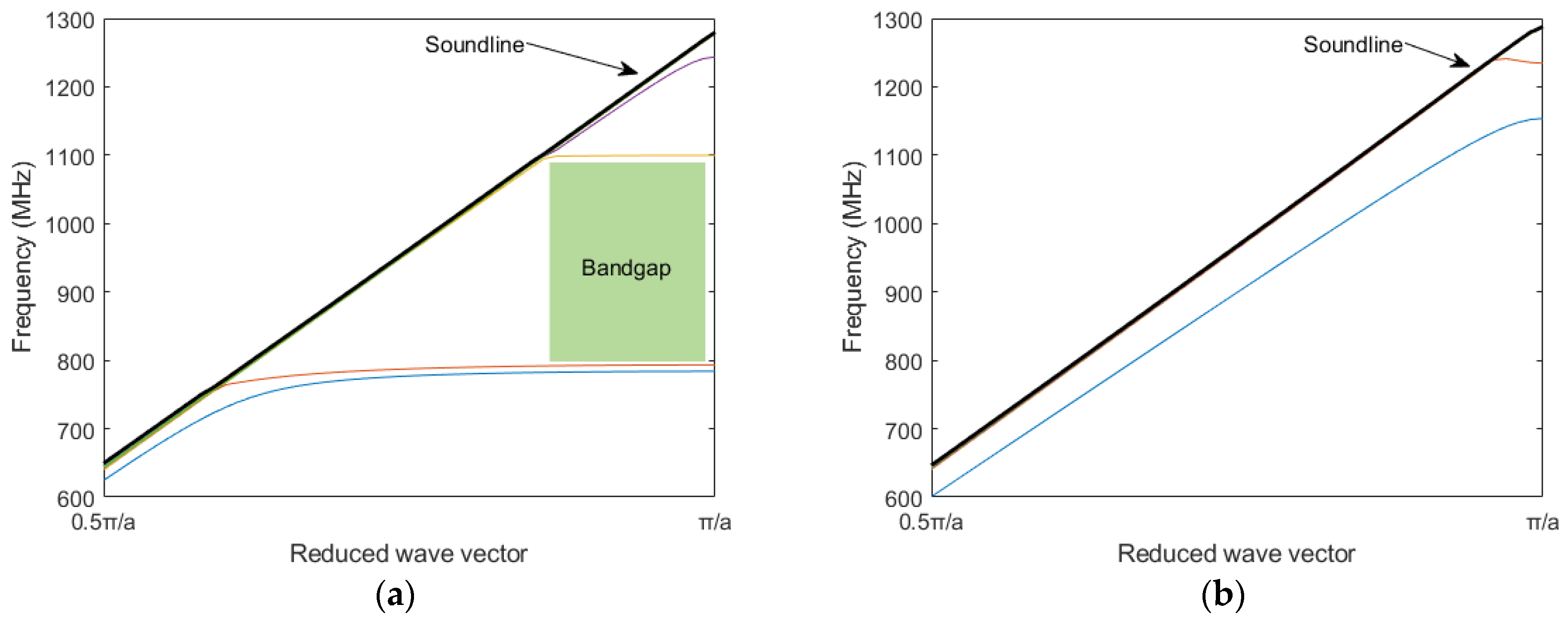
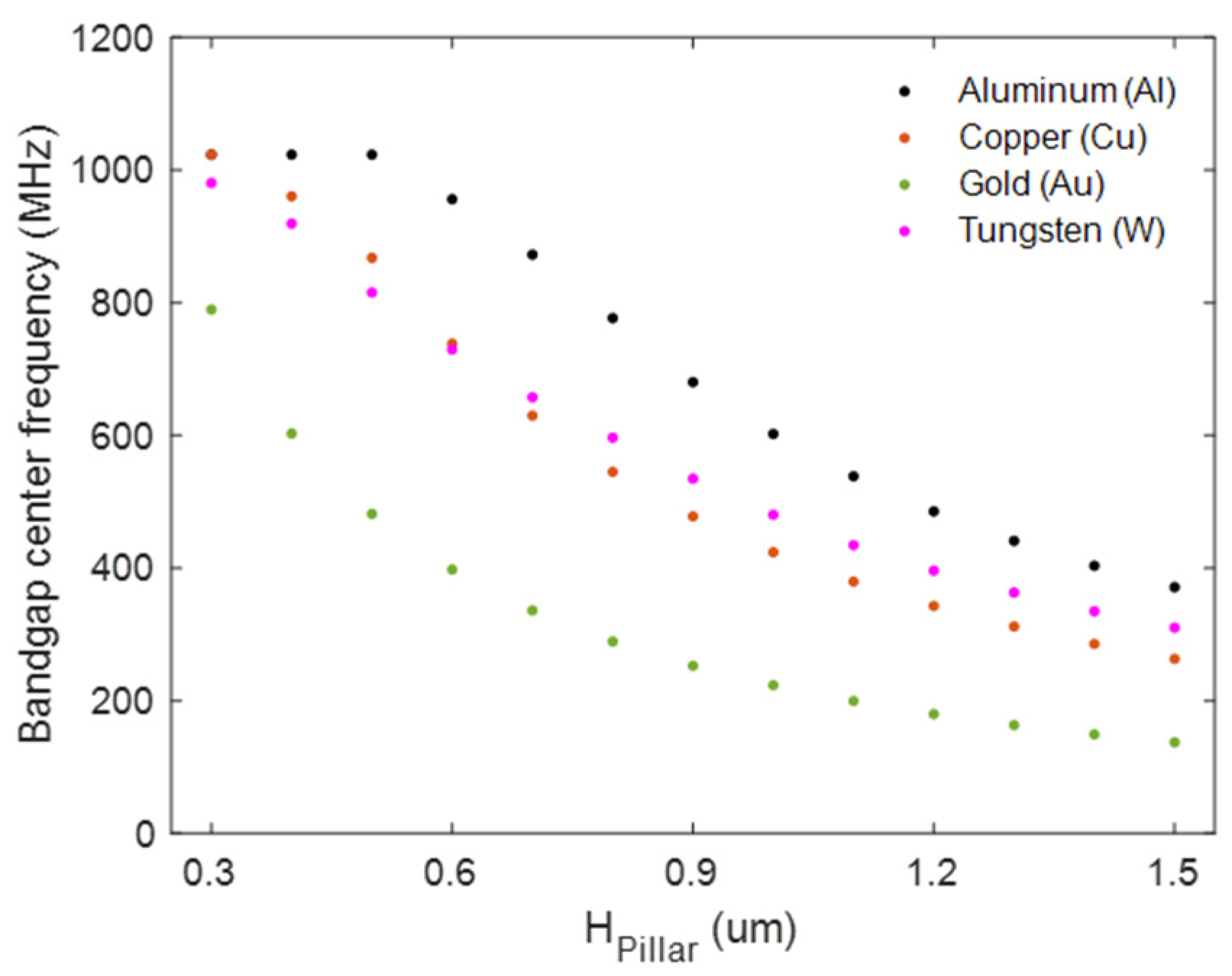
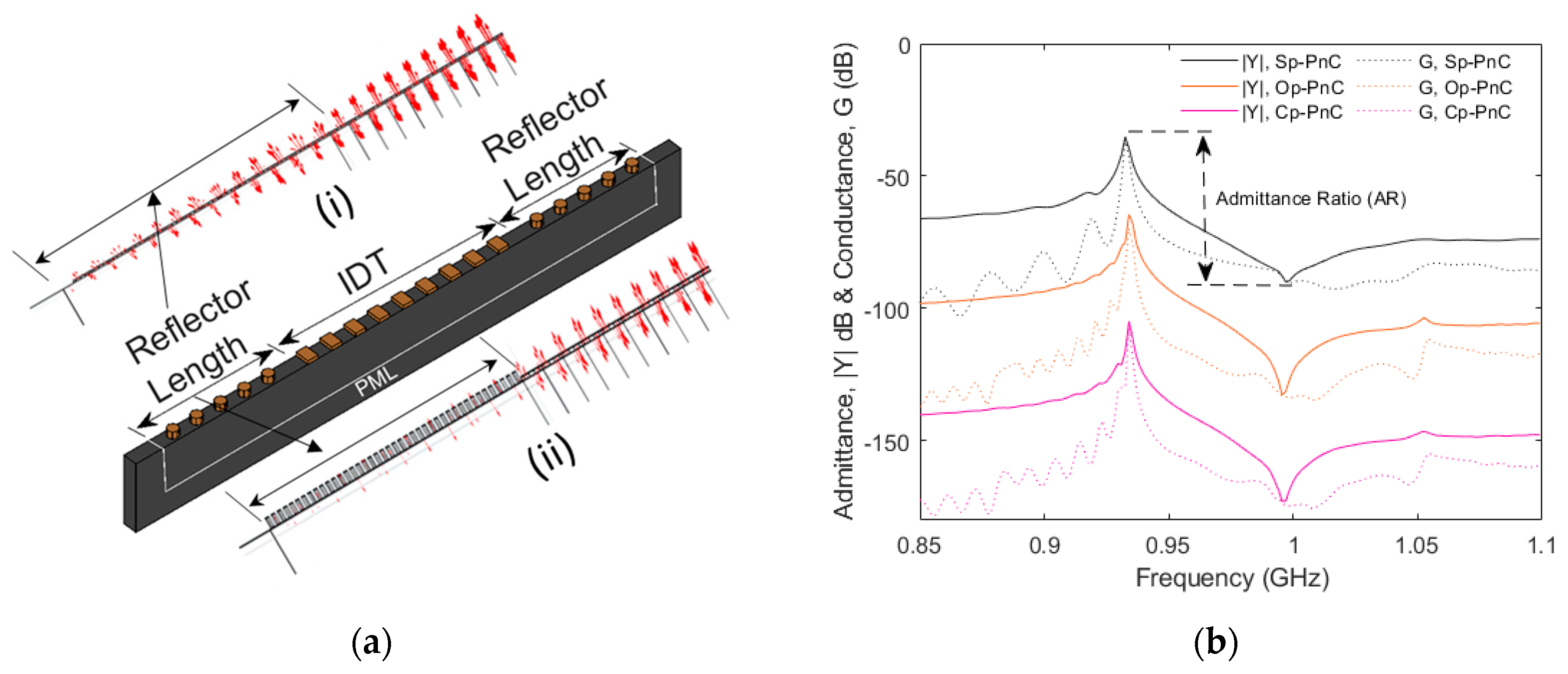



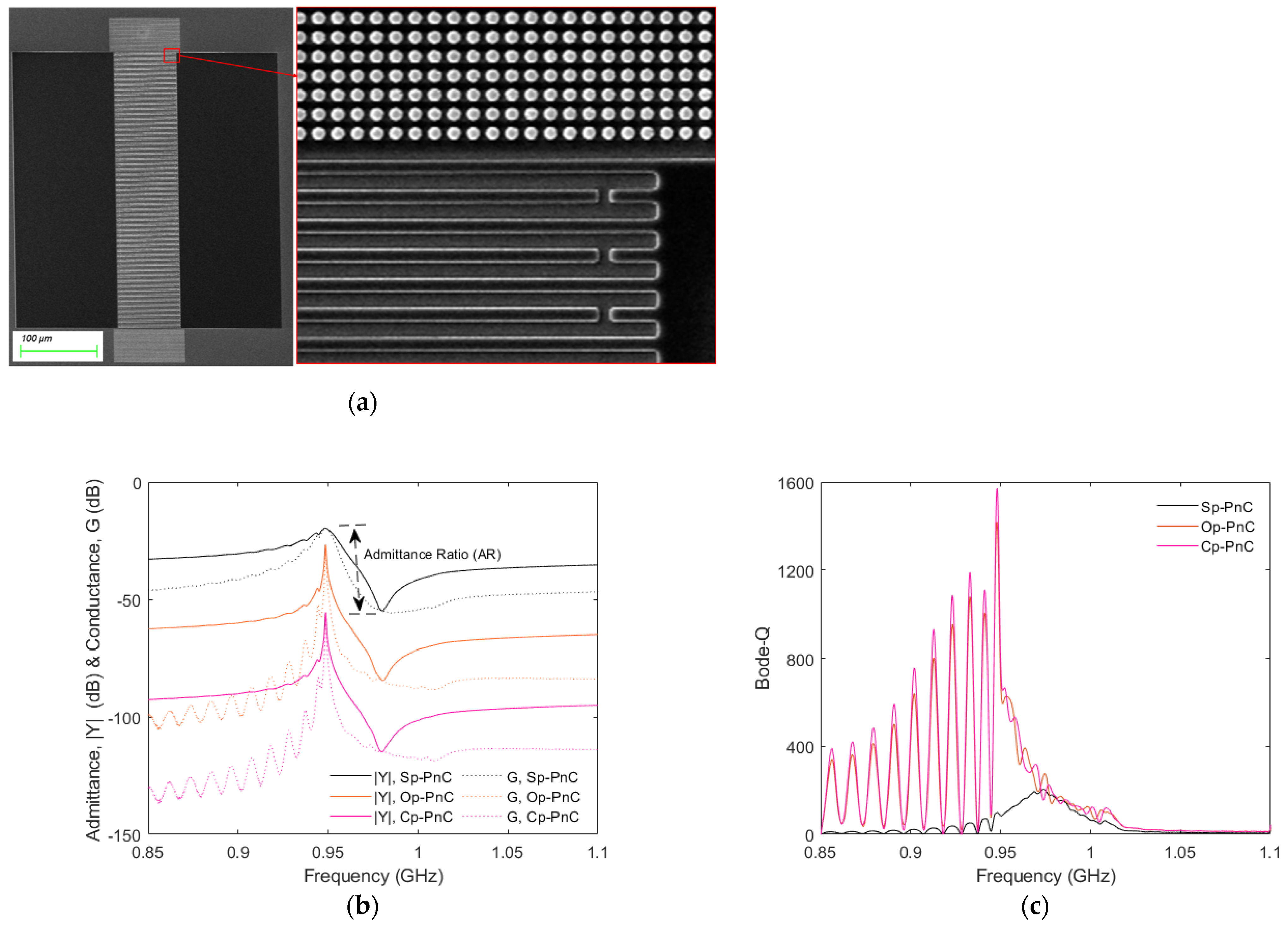


| Metal | Density () (g/cm3) | Acoustic Velocity (V) (m/s) | Acoustic Impedance (Z) (MRayl) 1 | ||
|---|---|---|---|---|---|
| Longitudinal | Shear | Extensional | |||
| Aluminum (Al) | 2.7 | 6420 | 3040 | 5000 | 17.1 |
| Copper (Cu) | 8.96 | 4760 | 2325 | 3810 | 42.1 |
| Gold (Au) | 19.32 | 3240 | 1200 | 2030 | 62.2 |
| Tungsten (W) | 19.25 | 5410 | 2640 | 4320 | 100.5 |
Disclaimer/Publisher’s Note: The statements, opinions and data contained in all publications are solely those of the individual author(s) and contributor(s) and not of MDPI and/or the editor(s). MDPI and/or the editor(s) disclaim responsibility for any injury to people or property resulting from any ideas, methods, instructions or products referred to in the content. |
© 2025 by the authors. Licensee MDPI, Basel, Switzerland. This article is an open access article distributed under the terms and conditions of the Creative Commons Attribution (CC BY) license (https://creativecommons.org/licenses/by/4.0/).
Share and Cite
Workie, T.B.; Zhang, L.; Shen, J.; Jiang, J.; Yao, W.; Shen, Q.; Bao, J.; Hashimoto, K.-y. Experimental Demonstration of Nanoscale Pillar Phononic Crystal-Based Reflector for Surface Acoustic Wave Devices. Micromachines 2025, 16, 663. https://doi.org/10.3390/mi16060663
Workie TB, Zhang L, Shen J, Jiang J, Yao W, Shen Q, Bao J, Hashimoto K-y. Experimental Demonstration of Nanoscale Pillar Phononic Crystal-Based Reflector for Surface Acoustic Wave Devices. Micromachines. 2025; 16(6):663. https://doi.org/10.3390/mi16060663
Chicago/Turabian StyleWorkie, Temesgen Bailie, Lingqin Zhang, Junyao Shen, Jianli Jiang, Wenfeng Yao, Quhuan Shen, Jingfu Bao, and Ken-ya Hashimoto. 2025. "Experimental Demonstration of Nanoscale Pillar Phononic Crystal-Based Reflector for Surface Acoustic Wave Devices" Micromachines 16, no. 6: 663. https://doi.org/10.3390/mi16060663
APA StyleWorkie, T. B., Zhang, L., Shen, J., Jiang, J., Yao, W., Shen, Q., Bao, J., & Hashimoto, K.-y. (2025). Experimental Demonstration of Nanoscale Pillar Phononic Crystal-Based Reflector for Surface Acoustic Wave Devices. Micromachines, 16(6), 663. https://doi.org/10.3390/mi16060663










